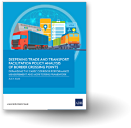Aboard the Global Value Chain (GVC) express: Implications for small and medium enterprises (SMEs)
When one thinks of the GVC concept, a flux of multinational companies involved in this global process comes to mind—whether it is Nutella’s global sourcing of our favorite Hazelnut spread, Japan’s auto giants integrating resources from a global supply chain to produce their end products, or a complex web of electronic components weaving its technology-induced pricing power through various countries. One may think global means size, however, this narrow scope of interpretation does not do justice to the ongoing phenomenon that is the GVC.
An avenue for SMEs’ growth
GVCs do not only provide opportunities for multinational enterprises and large companies with international operations, they present SMEs with diverse opportunities in an increasingly global production sphere. Given SMEs form the majority of the workforce, particularly in Asia, and are the engine of growth for most developing economies, efforts to enhance SMEs’ ticket aboard the GVC train can benefit individuals, local communities and regions alike, hence fast-tracking an economy’s journey to high-income growth.
Why should SMEs participate?
So why would a business owner who is comfortable in his local supply chain want to jump aboard? Keeping in mind integration into GVC requires an already established self-sustaining and cash-producing SME operation, there are a number of advantages in SMEs participation in GVCs.
Firstly, according to a 2008 OECD report on ‘Enhancing the Role of SMEs in Global Value Chains’, participation in GVCs may provide SMEs with a number of benefits, including stability and productivity improvements through new niches for the supply of products and services at lower costs. If SME owners take a proactive as opposed to a reactive approach, SMEs can position themselves quickly to capture opportunities in new production areas. This internationalization of production, through increased outsourcing and development of GVCs, can have a significant impact on SMEs.
Secondly, participation in GVCs provides new avenues of growth for SMEs looking to expand. New finance growth opportunities, uncovering more efficient suppliers and untapped markets, and mutually-beneficial networking relationships with other SME owners are all potential gains by small business owners who board the cabins of the GVC express, as opposed to the risk and reality of stagnation when limiting themselves in local or in some cases, even suburban supply chains.
What needs to be done?
The OECD report also mentions in order for SMEs to fully capitalize on these potential gains, they will need to upgrade their management, financing and technology capabilities to shift to an international network. As the world globalizes, the heads of SMEs need to adapt and think globally also. Through creation of formal networks and penetrating industry clusters, SMEs can develop a network of upstream and downstream partners to meet these challenges.
However for many aspiring SMEs—many of which lack resources compared to the global behemoths that dominate the industrialized world—assistance from governments, small business associations, and industry groups can be the catalyst for successful GVC integration. A supportive policy and business environment, where SMEs are spared the tedious process of tackling non-tariff barriers (NTBs), is an important element in integrating onto the GVC express. An OECD trade policy paper notes that tariffs and NTBs, such as inconsistencies in customs procedures and domestic regulations, can create additional burdens for SMEs pursuing entry into GVCs, and can add significant trade and transaction costs. Much like eliminating the need to change gauges aboard an express cargo train, NTBs will have to be reduced or eliminated for SMEs to be attractive to other firms upstream and downstream in the GVC.
To conclude, how realistic is it for SMEs to integrate into GVC given the benefits? In essence. it comes down to a variety of factors, and unfortunately for some SMEs, especially those that are less established or have a grand vision but lack the know-how of efficient operations, chances are, they will miss this train. The right mix of domestic, regional and global sourcing experience, supportive policy and business environments, cultural learning, a natural sense of identifying your competitors, and having the tenacity to capture sourcing opportunities to enhance bargaining power, will be key to many SMEs’ integration into the GVCs.
*Ka Wai Wong is an Economic Development Officer working for The Asia Foundation based in Bangkok. He works on economic development projects in developing countries across Asia.




